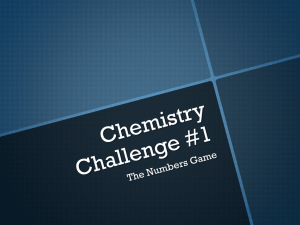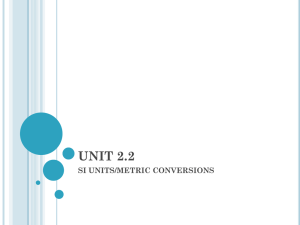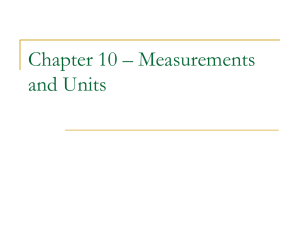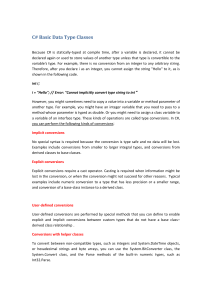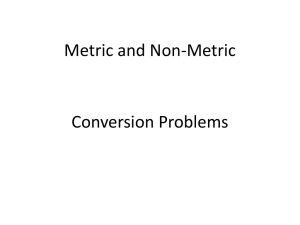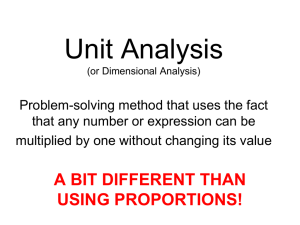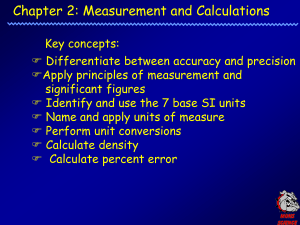Energy Conversion Project - Center for Learning in Action
advertisement
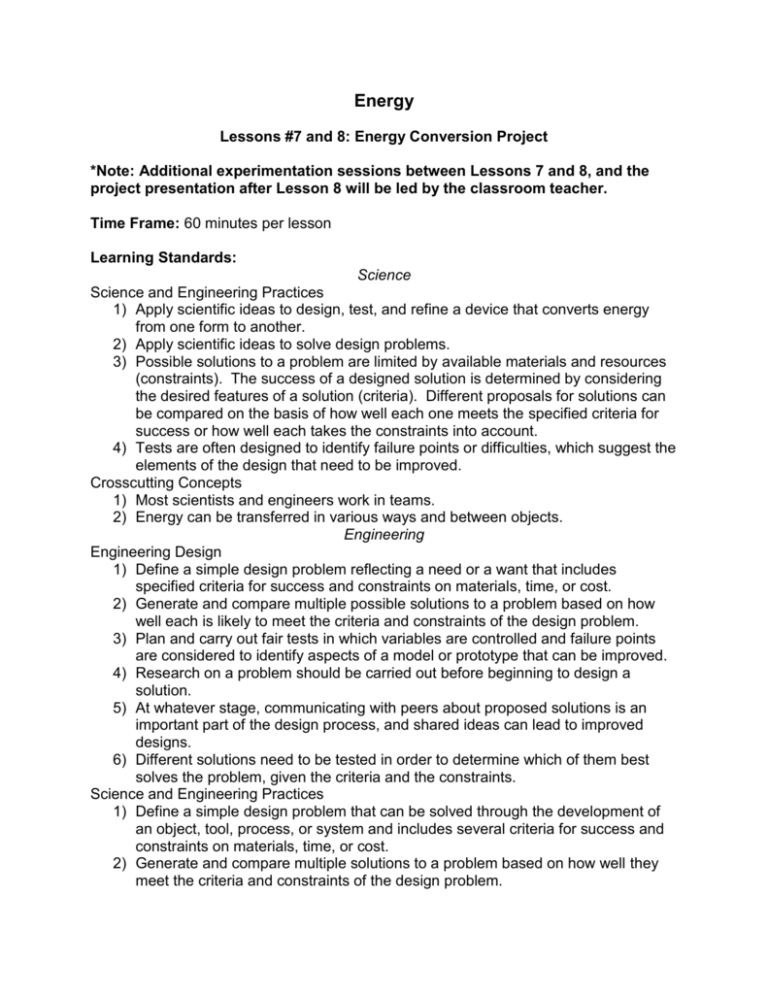
Energy Lessons #7 and 8: Energy Conversion Project *Note: Additional experimentation sessions between Lessons 7 and 8, and the project presentation after Lesson 8 will be led by the classroom teacher. Time Frame: 60 minutes per lesson Learning Standards: Science Science and Engineering Practices 1) Apply scientific ideas to design, test, and refine a device that converts energy from one form to another. 2) Apply scientific ideas to solve design problems. 3) Possible solutions to a problem are limited by available materials and resources (constraints). The success of a designed solution is determined by considering the desired features of a solution (criteria). Different proposals for solutions can be compared on the basis of how well each one meets the specified criteria for success or how well each takes the constraints into account. 4) Tests are often designed to identify failure points or difficulties, which suggest the elements of the design that need to be improved. Crosscutting Concepts 1) Most scientists and engineers work in teams. 2) Energy can be transferred in various ways and between objects. Engineering Engineering Design 1) Define a simple design problem reflecting a need or a want that includes specified criteria for success and constraints on materials, time, or cost. 2) Generate and compare multiple possible solutions to a problem based on how well each is likely to meet the criteria and constraints of the design problem. 3) Plan and carry out fair tests in which variables are controlled and failure points are considered to identify aspects of a model or prototype that can be improved. 4) Research on a problem should be carried out before beginning to design a solution. 5) At whatever stage, communicating with peers about proposed solutions is an important part of the design process, and shared ideas can lead to improved designs. 6) Different solutions need to be tested in order to determine which of them best solves the problem, given the criteria and the constraints. Science and Engineering Practices 1) Define a simple design problem that can be solved through the development of an object, tool, process, or system and includes several criteria for success and constraints on materials, time, or cost. 2) Generate and compare multiple solutions to a problem based on how well they meet the criteria and constraints of the design problem. English / Language Arts 1) Recall relevant information from experiences or gather relevant information from print and digital sources; summarize or paraphrase information in notes and finished work, and provide a list of sources. 2) Draw evidence from literary or informational texts to support analysis, reflection, and research. Student will be able to: 1) Design and construct a machine that uses energy conversion to accomplish a goal. 2) Present and explain their machines and process. Resources and Materials: Item Science Journals iPads Energy Conversion Project Instructions Energy Conversion Project Presentation Guidelines Energy Conversion Project Rubric Energy Conversion Project Materials Measuring tape Bells Containers String Balls (Ping pong balls and tennis balls) Cups Wires Sticks Cardboard tubes Blocks Pinwheels Ramps Cans Tape (not provided) Scissors (not provided) Paper (not provided) Water (not provided) Amount 25 (in bin) 25 (in bin) 25 (in bin) 1 set (in bin) This project will span 3 class periods, with additional time set aside outside of the science block to finish testing. The first class period, under Energy Lesson 6 includes the research portion of the project. If you have enough time at the end of the semester for 3 lessons, then feel free to teach Lesson 6 yourselves, with the agreement of your classroom teachers. If not, then discuss with your classroom teacher so that they know to teach the lesson during the week between Lessons 5 and 7. Energy Lesson 7: This lesson will be the first testing period for the students. Students should already know their groups and know that they will be working on a project that involves energy conversions. Hand out the “Energy Conversion Projection Instructions,” “Energy Conversion Project Presentation Guidelines,” and “Energy Conversion Project Rubric” handouts at the beginning of class and answer any questions that students have after reading the instructions. Allow students at least10 minutes to gather in their groups, figure out which goal they want to aim for, what materials they will use, and how they plan to build a structure to accomplish their goal. These decisions may change as they experiment and refine their design. Remind students that failure is important to the scientific process, and scientists use failure as a way to identify elements of a design that need to be improved. The important thing is not only to complete the goal, but to try to come up with and test multiple solutions. Help students brainstorm different approaches to solutions. Students should be documenting their progress as images or videos on the iPads or as observational notes in their science journals throughout the testing process. After testing, attempting to refine, and then comparing these different trials, they should conclude that one of their solutions is their best and should be able to provide reasons for their decision. By the end of this lesson, students should have documentation of their structures and how they created them as well as a conclusion about which solution works best. Note: It is recommended that classroom teachers work with their students using the Explain Everything app throughout the semester, but check in with the teachers after Lesson 7 to make sure that they have done so. If not, kindly ask the teachers to do some sort of mini project with the students using Explain Everything before Lesson 8. Also, familiarize yourself with the app before going in to teach Lesson 8. Between Lessons 7 and 8: Classroom teachers are encouraged to give students more time to experiment with their designs outside of the science block. 1-2 more 45 minute sessions of construction during the week is suggested. If time permits, students are encouraged to visit other teams to “show and tell” their machine ideas during the last construction session. Energy Lesson 8: Students will use this lesson to prepare for and create a presentation on their energy conversion project using the Explain Everything app on their iPads. If students have kept their structures in the classroom, they may go back to their structures to get any pictures or videos that they did not get during Lesson 7. Remind students that they should include a video of a successful run of their completed project in their presentation. Students should start working on their presentation as a group. The presentation should roughly follow the structure of the steps of the scientific method. It should present the problem they attempted to solve, something about their research (refer back to their notes from Lesson 6), their initial ideas about how to go about solving the problem, details about the trials they ran and how they planned to compare different solutions, the results of their tests, their reasons for picking any particular solution, and their conclusions. If students finish before the hour long section is done, they can practice giving their presentation in the hallway (if they choose not to use voiceovers in their presentation), or spend time watching their presentations to make sure everything is in place. Students will not give their presentations until later in the week with their classroom teachers, but unless the classroom teacher expects to be able to give them more time to work on the presentations after this lesson but before they have to present, students should be completely done with their presentations by the end of this lesson. While wrapping up the lesson, make sure that all student presentations have been saved successfully. Project Presentations: Classroom teachers will facilitate the project presentations in their classes sometime after Lesson 8. Students will show their Explain Everything presentations, which should include videos of their experimental trials. If possible, students can also show off their machines and do a live trial during their presentation. Classroom teachers will grade the student projects based on the “Energy Conversion Project Rubric”. Assessment: Science journals, see rubrics Name:____________________________________________ Date:______________ Energy Conversion Project Instructions Start by discussing this project with your group members. For this project, you will have to complete one of the goals listed below while using the materials provided and completing all of the machine requirements. There are no limits to the amount of each material you can use. Figure out which construction goal your group wants to do and how you plan to complete that goal. Remember to keep the machine requirements in mind and think about the materials you plan to use. Think back to everything you've learned already about energy and look at your notes for ideas. Don't be afraid to make mistakes or have to start over, and continue to try new ideas! You will also be doing a presentation on how you did this project, so take pictures! Construction Goal: Build a machine that does at least one of the following: ● Move a ping pong ball at least 1 meter from its starting position ● Ring a bell ● Increase the water level in a container by 2 cm Machine Requirements: ● Design a machine that shows at least three different energy conversions ● The machine must use at least two different forms of energy - students can choose between radiant, thermal, sound, chemical, electrical, kinetic mechanical, and potential mechanical energy ● The machine must demonstrate the energy conversions and different forms of energy before accomplishing the goal Presentation Goals: 1. Show documentation of the designing and construction process 2. Clearly point out when energy conversions take place in the machine 3. Clearly show the different forms of energy the machine uses Time Constraint: ● 2-3 hours of planning and testing time ● 1 hour to create presentation Materials at your disposal: String Cardboard tubes Balls (ping pong balls and tennis balls) Blocks Cups Pinwheels Wires Ramps Sticks Cans You can also use anything else you find inside your classroom, with permission from your teacher. For example: tape, scissors, paper, water/faucet Name:______________________________________ Date:______________ Energy Conversion Project Presentation Guidelines All of these ideas should be in your presentations: ● An introduction slide with all of your names ● Ask a Question: Tell us the first goal you decided to try and why ● Present Background Research: Tell us some details about the energy sources you used in this project (look back on your notes from the readings) ● Construct a Hypothesis: Your first plan to try to solve the goal and why you thought that would work ● Experiment and Make Observations/Collect Data: Tell us about your experimental process: how you tested your structures, whether you had to make any big changes, any other solutions you tried, things you noticed and learned. ● Analyze Your Results and Make a Conclusion: Tell us about how well you think your design worked: did it complete all of the requirements? What types of energy did you use? Would you change anything about your design if you had more time? ● Tell us something you learn from doing this project ● Tell us something you enjoyed the most while doing this project Remember to work together on this project. Also, remember that you will want pictures for your slides, and maybe videos or sounds. It's nice to have pictures of your actual process, so don't forget to take pictures, notes, or videos while you're testing your solutions. Energy Conversion Project Rubric Student Name:_________________________ Machine Construction Category Completed Selected Construction Goal 4 Students were able to build a machine that can successfully complete their goal every time. 3 2 1 Students were able to build a machine that successfully completed their goal most of the times. Students were able to build a machine that successfully completed their goal at least once. Students could not complete the goal. Displayed Energy The machine used Conversions and at least 2 forms of Types energy and showed at least 3 energy conversions. The machine used at least 2 forms of energy and showed at least 2 energy conversions. The machine used at least 2 energy conversions, but did not show 2 forms of energy The machine used only 1 energy conversion and 1 form of energy. Creative Use of Materials Students used at least 8 of the provided materials in innovative ways. Students used at least 7 of the provided materials. Students used at least 5 of the provided materials Students used 4 or less of the provided materials. Experimentation and Trials Students experimented with different machines prototypes and executed multiple trials on each machine. Students experimented with different machine prototypes and executed at least 1 trial on each machine. Students executed multiple trials on 1 machine prototype Students only executed 1 trial on 1 machine prototype. Teamwork and Participation Students exhibited superb teamwork. Everyone communicated their ideas and contributed to the work. Students worked well together, but were not all able to successfully communicate their ideas to the group. Students did not work well together or did not attempt to incorporate everyone’s ideas. Students did not work together, or a member of the team did not participate at all. Final Grade: __________________________ Comments: Presentation Category 4 3 2 1 Fulfillment of Required Presentation Goals Clearly points out different energy forms and energy conversions used in the machine, and incorporates picture and video evidence. Attempts to point out different energy forms and energy conversions used in the machine. Points out either energy forms or energy conversions used in the machine, but not both. Does not point out the energy forms or energy conversions used in the machine. Understanding of Underlying Concepts Clearly explains the mechanics of the energy conversions and describes the forms of energy used. Attempts to explain the mechanics of the energy conversions, and includes some explanation of the forms of energy used. Explains either the mechanics of the energy conversions or the forms of energy used, but not both. Does not explain the mechanics of the energy conversions or the forms of energy used. Presentation Skills and Creativity Presents information clearly and effectively in ways that engaged other students. Presents information clearly and effectively, but does not engage other students. Presentation was somewhat confusing, but other students can still reach a basic understanding of main ideas. Presentation was very confusing. Teamwork and Participation Students worked extremely well together. All students were very involved in the presentation and understood all aspects of the presentation. All students were involved in the presentation, but some students did not understand aspects of the presentation. Most students were involved in the presentation, and most understood all elements of the presentation. One student did most of the presentation. Other students did not understand many elements of the presentation. Spelling and Mechanics The presentation contains no mistakes, or only a few negligible mistakes. There were a few mistakes, but does not detract from the overall presentation. The presentation The presentation included some included many obvious mistakes. mistakes that made understanding difficult. Final Grade: __________________________ Comments:
